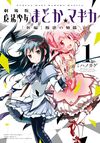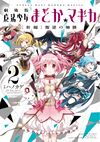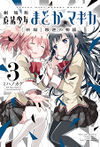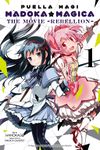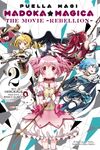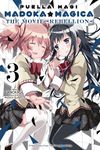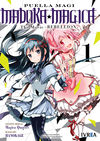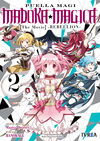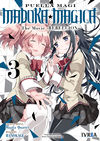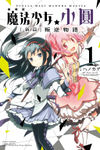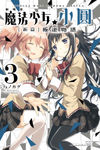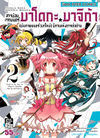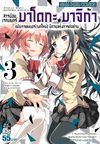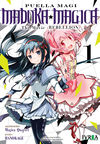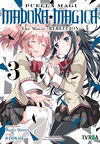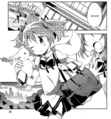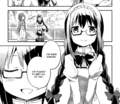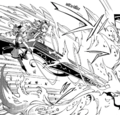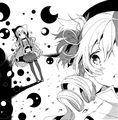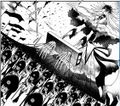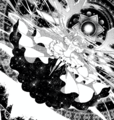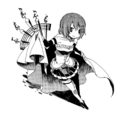Puella Magi Madoka Magica: The Movie -Rebellion- Manga
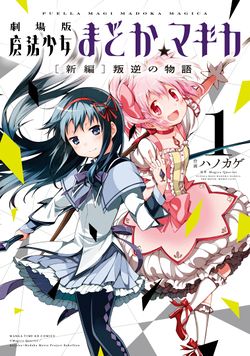
A manga adaption of Puella Magi Madoka Magica the Movie: Rebellion, titled Puella Magi Madoka Magica: The Movie -Rebellion-. The adaptation was created by Hanokage based off of Gen Urobuchi's scenario for the movie. Three volumes were released in total, with the first containing chapters 1 - 3, the second containing chapters 4 - 6, and the third containing chapters 7 - 9. Like Madoka Magica and The Different Story before it, the Rebellion manga was not serialized in a magazine beforehand.
Initially, the English release of the manga was announced to be released as a single hardcover collection, on June 23, 2015. However, on April 21, 2015, Yen Press said that they could not release the manga as a hardcover collection for unexplained reasons, and would instead release the manga in its individual paperback volumes later in the year.[1]
Blurb
- Collection (discontinued)
- With Madoka Kaname’s sacrifice, the hopeless cycle that once bound every magical girl to a terrible fate was broken at last. Still, the magical girls fight on against the dark magics that threaten the human world, which remains ignorant of the brave girl who saved them. Only Homura remembers her dear friend Madoka, a burden she has borne in all her battles since — right? Then how is Homura still going to school with Madoka, fighting alongside her, laughing as if nothing has happened? As her tragic memories return to her, Homura realizes she must not be in the real world, wonderful as it is to see her friend again. But if she is indeed trapped in a magical space, who among her magical friends could be the cause?
- Volume 1 (Hachette Books blurb)
- With Madoka Kaname's sacrifice, the hopeless cycle that once bound every magical girl to a terrible fate was broken at last. Still, the magical girls fight on against the dark magics that threaten the human world, which remains ignorant of the brave girl who saved them. Only Homura remembers her dear friend Madoka, a burden she has borne in all her battles since — right? Then how is Homura still going to school with Madoka, fighting alongside her, laughing as if nothing has happened?
- Volume 1 (volume cover blurb)
- With Madoka Kaname's sacrifice, the hopeless cycle that once bound every magical girl to a terrible fate was broken at last. Or was it...? All does not seem right with the world, and as Homura pulls at the loose threads of the girls' new reality, is it possible that an even darker destiny looms ahead?
- Volume 2
- Homura discovers that she has been trapped in an illusionary space all along. Though she resolves to find and put a stop to the culprit behind the illusion, her friends' apparent happiness in this false reality makes Homura wonder if she has more to lose than gain by putting an end to it. And when an old foe shows up, Homura's decision becomes even more complicated...
- The manga adaptation of the record-breaking hit Puella Magi Madoka Magica: The Movie -Rebellion- continues on!
- Volume 3
- When Homura is unable to stop her transformation into a witch, it's up to Madoka and the others to save her! Will Madoka be able to reach Homura before she becomes stuck in a void of painful memories? And if they do make it out of the illusion, to which reality will the girls return? The manga adaptation of Puella Magi Madoka Magica: The Movie -Rebellion- barrels toward an unforgettable conclusion!
Differences from the movie
While the Rebellion manga is much more faithful to the film's story and events than the anime's manga, there are still many notable differences between the manga and film — mostly those of imagery, due to differences in the types of media. This section is an attempt to list them.
Volume 1
- The first Nightmare battle has some slight changes:
- Mami's ribbons are seen blocking the way the Nightmare initially goes. These ribbons have "keep out" written on them in fancy font.
- Kyoko's and Sayaka's clash with the Nightmare is slightly extended. There is also an extra line, "All according to plan", added in.
- The Nightmare, instead of heading through several doors, heads through a window, into a world with antique houses and pine trees, and through another window into the end room.
- The Holy Quintet is seen explicitly singing the "Mada dame yo" lullaby. The art during this sequence is slightly stylized.
- There is a shot of Homura in the background; interestingly, she has one of Mami's ribbons tied at her ankle.
- The "bomb" is an hourglass object instead of an egg-like object from a cup.
- Bebe, instead of chewing on Mami's hairpin, chews on a perfume bottle instead, spraying herself in the face.
- Mami stripping her towel is, thankfully, portrayed much less explicitly. Bebe is seen getting the towel accidentally thrown on her.
- The Holy Quintet transforms from a street instead of on top of a building. Their transformations are also largely condensed into fancy single-panel displays.
- Kyoko is seen eating biscuits instead of drinking juice. She thus takes a few moments to react to the Nightmare after Sayaka calls her name, whereas in the film she acts immediately.
- The Cake Song is told in a much more cutesy art style, with everyone turn into chibi.
- Bebe does not transform into her caterpillar form when Hitomi is restored. Hitomi and Kyosuke also disappear into the night going up a path resembling the path to Madoka's heaven.
- When Homura starts to feel unsure of her memories, the unnamed people around her have missing faces instead of burnt ones.
- There is a small conversation where Madoka and Sayaka head out shopping, explaining what they were doing during Homura's and Kyoko's investigation. Sayaka also invites Kyoko along, but Kyoko refuses, to which Sayaka teases that they were going to eat out; Kyoko, embarrassed, asks if they can buy some for her.
- As Homura says that Kyoko's current personality doesn't match up to how she remembers, there are a few shots of the antagonistic, fish taiyaki-eating Kyoko from the scene in Episode 5 where she confronts Sayaka over trying to hunt a familiar.
- Kyoko has a more shocked reaction when she asks Homura if she's trying to pick a fight. She also spins and dramatically points with her fries.
- When Homura prevents Kyoko from transforming, she only puts her hand out to stop her summoning her soul gem, standing from a distance, instead of "hugging" Kyoko from behind.
- The surrounding people have blank faces and holes for eyes instead of strange Homura and Kyoko masks.
- Kyoko throws Homura a sweet in polka-dot wrapping instead of a swirl lollipop.
- Homura's monologue on how the world is a witch's barrier, and her monologue on Madoka's sacrifice how witches were erased, are merged together into one monologue.
Volume 2
- There is a new scene at the beginning of volume 2 that is not present in the movie. Homura, with her glasses and braids removed, is walking to school, where she is approached and greeted by Mami and Bebe. Mami remarks how Homura looks stunning with her new look, and that Mami almost didn't recognize her at first. Homura then asks if Mami has spare time after school, leading in to the scene that takes place in Mami's apartment.
- Mami does not hug Bebe to her chest in the scene where she talks about how being a magical girl has been for her.
- Mami's ribbon is never seen, whereas in the film there is a quick shot of it flickering behind Homura.
- Homura goes for Bebe's neck immediately, instead of grabbing her by the head and then by the neck.
- Instead of slamming Bebe into the side of a building, Homura stands on top of one of the pin-like structures and strangles her.
- When Mami pulls Homura off the ledge she's on, Homura slams her shield into the side of the nearest building to slow her fall, before grabbing onto another ledge. Homura also falls upside down, and uses the shield move to get upright.
- Bebe's polka dot form has the face of her caterpillar form.
- Mami draws one of her guns as she challenges Homura, instead of waiting until Homura to strikes first to summon it.
- The fight scene is drawn somewhat differently and appears to take place in different building structures, but overall resembles the film's version. There is never a lone part where Mami swings from parts of a building with her ribbons to avoid Homura's bullets; this part is merged into the one where she asks if Homura can beat her in a head-on fight.
- Instead of pointing guns at each other, Mami and Homura stand apart, empty-handed. They also cover their ears when the explosions are set off, whereas in the film they did not react.
- Instead of shooting herself in the head to fool Mami, Homura throws away her shield and shoots down a building, causing it to collapse on the girls and cut Mami's ribbon, catching her shield as she falls. She comes off somewhat wounded by the collapse, but not overly bloodied.
- The fake Mami turns into a doll as she collapses into ribbons. Homura also does not shoot the ribbons as they converge on her.
- Homura is more distressed as she yells at Mami.
- Mami tries to hit away the fire extinguisher Sayaka throws with one of her guns, but misses.
- The scene where Nagisa apologizes to Mami and asks her to listen is intercut by Sayaka carrying Homura away; the film had no such intercut.
- The scene between Homura and Sayaka has several changes:
- Sayaka does not take her sword out of a sheath as she frees Homura; her sword is also smaller and resembles a conductor's wand. She also grabs one of the fluttering flowers before tossing it away; Homura flips her hair to get the flowers out.
- Homura appears to try and take a gun out of her shield instead of grabbing the shield to stop time, as her fingers creep behind the shield. Sayaka still makes the same "trying to return to your own time?" comment, however.
- As Homura says that "witches are the final form of the magical girl" there is a shot of Mami's soul gem becoming a grief seed.
- Sayaka does not dance in the water when asking Homura if the world they're in is really so bad.
- Sayaka does not head-tilt when saying that "[I'm] the same Sayaka Miki [you've] always known". Instead, her form darkens and she smiles widely, resembling how she looked in her crazed fight versus Elsa Maria in Episode 8.
- In the quick confrontation between the two, Sayaka throws her sword at Homura's shield, and she bashes it away with her shield, instead of Sayaka trying to stab the shield and Homura kicking her in retaliation.
- A silhouette of Oktavia is seen in Sayaka's cape when Homura stops time.
- The cape gets pinned by Sayaka's sword; Homura kicks it away as she releases the time-stop.
- Flashes of the ribbon-wearing Homura fighting wraiths are seen as Homura monologues on how magical girls must always continue to fight.
- Homura never gets on a boat. Madoka jumps down from a tall bridge and lands on her feet, yet Homura is knocked down by Madoka's landing.
- The flower field scene has several changes:
- Madoka and Homura are never seen walking to the field; the scene cuts to them directly in the field.
- Homura is seen huddling in an upright fetal position in the flowers; thus she never runs out into the field, nor does she crouch over and cry on her knees.
- Homura has a flashback to when Madoka was disappearing in the space-time void in Episode 12 as she realizes that she made a mistake letting Madoka make her wish. She also flashbacks to the scene where Madoka is making her wish in the city ruins.
- Homura turns and hugs Madoka while telling her she is the "real Madoka".
- During the conversation, the flowers do not change form as drastically as in the film. Instead, they simply start to lose their petals and release dandelion clocks into the wind.
- Homura is more visibly distressed as she talks to Kyoko over the phone, lamenting her own stupidity.
- When Homura drops the phone, it is not seen floating to the ground like a feather.
- As Homura climbs the bus to test her soul gem, she flashbacks to scenes from Episode 6 where Madoka throws Sayaka's gem off the bridge.
- When shooting her soul gem, Homura picks it up from the table, throws it in the air, then shoots it, dropping the gun in the process.
- The scenes with Kyubey's explanation and Homura's witch transformation have several changes:
- The blanket-wearing Homura is seen in a hospital bed with an IV attached.
- Her dress is different; it resembles a black version of the one she wears in the Beginnings and Eternal OPs when reaching out for Madoka in the midst of a purple sea.
- Kyubey's explanation has different imagery, and some shots to scenes from the series. In particular, there are several shots of the ribbon-wearing, bow-wielding Homura.
- Homura's freak-out is also drawn differently, with different imagery. The imagery here is much cleaner and less cluttered than the movie.
- When Kyubey asks Homura "isn't this the happiness you wished for?", it connects to the final scene of the third volume of the original manga. Homura sheds her braids and glasses and runs happily after Madoka, but Madoka transforms off-panel into a dark, pistol-wielding version of the dress-wearing Homura, who shoots the happy Homura in the head. This might show her despair.
- After Kyubey says "Are you willing to lose your chance to meet Madoka Kaname ever again?", Homura is seen chanting Madoka's name desperately, then crying out "Don't leave me!" as she flashbacks to scenes from episodes 10 and 12. The real Homura then roars at Kyubey to shut up after this.
- Homulilly's first form is skipped during her transformation in the beehive — instead, she transforms straight into her second form. Also, instead of breaking out of the beehive building while transforming, she transforms while inside of it.
Volume 3
- The climatic battle has several changes:
- Kyoko is seen eating dango balls on sticks prior to the battle.
- Nagisa's transformation into her magical girl form is slightly different.
- The Sayaka and Kyoko confession scene, and Nagisa's interruption, is expanded on very slightly.
- Madoka, instead of having yellow ribbons in Homura's new world, has her hair down, until Homura gives her the red ribbons.
- In the epilogue, Homura is seen dancing in a tree instead of dancing in a field. She also sings "Mada dame yo" (まだだめよ) as she does so (she makes no sound at all in the movie, though she hums the song in the "Homura's First Take" version). Kyubey is also not present in this scene.
Publishers
Bonus material
A listing of all the bonus material that comes with the manga when purchased from certain vendors.
Volume 1
Volume 2
- Gamers: illustration card and A4 clear file
- Toranoana: clear file
- Melon books: hologram card illustration
- HMV: bromide
- Sanyodo: Homura illustration card
Volume 3
- Melon Books: Hologram card illustration
Gallery
Color pages
-
Volume 1 coloured illustration
-
Volume 2 coloured illustration
-
Volume 3 coloured illustration
-
Clara Dolls on the back cover of one of the volumes
-
Volume 2 Gamers bonus
Manga pages
-
Chapter 1 art
-
Ultimate Madoka
-
Madoka's pyjamas
-
Hitomi
-
Tiro Duet
-
Nagisa
-
Witch cameos
-
Homulilly
-
Oktavia
-
Mami's Tiro Finale cannon
-
Homura's Dark Orb
-
Devil Homura
-
Art from between chapters
See also
- Puella Magi Madoka Magica Manga
- Puella Magi Madoka Magica: Wraith Arc
- Puella Magi Madoka Magica the Movie
- Puella Magi Madoka Magica the Movie: Rebellion
